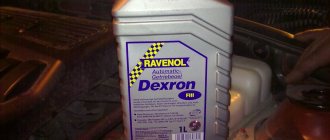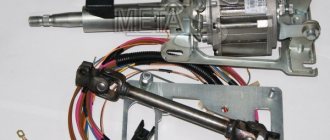01/19/2022 27,099 ECU
Author: Ivan Baranov
Hydraulic power steering is designed to make steering easier, as well as dampen vibrations and shocks that occur on the steering wheel. In order for it to last a long time and work stably, it is necessary to regularly change the oil in it and monitor its quality. The article discusses Dextron oils, including Dextron 3 for power steering, and gives their description, advantages and disadvantages.
[Hide]
How to spot a fake
The popularity of the manufacturer attracts scammers; a lot of counterfeits of this transmission oil are produced. Therefore, you need to know how to distinguish a fake:
- The original canister is marked with a branded hologram and a unique product code.
- The original plastic is of high quality, dense and flexible, smooth - without seams or roughness, uniformly colored.
- The text on the label is printed clearly and evenly, the translation into Russian is done correctly; It is mandatory to indicate tolerances, specifications, technical characteristics and manufacturer data.
To avoid encountering a counterfeit, you should purchase lubricant only from official distributors.
Results
You should not experiment with automatic transmissions, filling in different fluids and hoping for their compatibility. The best fluid for the machine is the one prescribed by the manufacturer. This will save you from expensive repairs, gear slipping, jerking, clicking and other troubles. The fact is that the parts are designed for a certain liquid, and the transition to even a higher quality and modern liquid can be disastrous for the parts.
5
Author of the publication
offline 1 month
What should you do if you accidentally mix transmission fluids?
But not everything is really that scary.
If you find yourself in an emergency situation in which you need to add oil to the system, but you cannot find the exact same fluid, then you will have to choose the better of two evils - either mix the existing oils, or continue driving without sufficient lubrication.
Movement without lubrication will lead to failure of the unit after just a few tens of kilometers. Using the mixture will allow you to get to a service center where you can completely change the oil.
If transmission oils from different manufacturers or brands are accidentally or intentionally mixed, then the best option would be to get to the nearest service point, where the fluid must be completely drained and replaced (with flushing the system) with one recommended by the car manufacturer.
Features of transmission oils
First of all, I would like to note that there is no single recipe for transmission oils. Despite the fact that the main components of such materials are base fluids (mineral, synthetic or semi-synthetic) and additives, the composition and proportions of these components can vary greatly not only among oils of different brands, but also among brands of the same manufacturer.
So, for example, the line of one brand may contain mineral and synthetic oils with different or similar temperature-viscosity characteristics, with approvals from different automakers, different groups according to different quality level classifications. This indicates that such liquids, even having approximately the same performance properties, can have different chemical compositions.
At the same time, modern automobile oils from major manufacturers are certified according to the API standard. One of the mandatory requirements of this standard is the compatibility of oils within the same classification category.
In other words, if gear oils have received such a certificate, then no matter who the manufacturer is and what brand it is produced under, they can be mixed without any harmful consequences.
However, this is theoretical. In practice, the requirements put forward by the API standard are not enough for many automakers.
To ensure the reliable operation of their vehicles, they put forward more stringent and specific requirements. Only those products that have passed special tests and received the appropriate approvals and recommendations are allowed for use in transmissions or engines.
Thus, oils of different brands, even if they are similar in most parameters, can differ significantly in some of them and do not meet the requirements that the car manufacturer sets for service materials.
Characteristics of Dextron 2 and 3 - what are the differences
Dexron 2 and 3 fluids , which are used in power steering and automatic transmissions, lie in their fluidity rates, type of base oil, and temperature characteristics. In general terms, we can say that Dextron 2 is an older product released by General Motors, and accordingly, Dextron 3 is a newer one. However, you cannot simply replace the old fluid with a new one. This can only be done by observing the manufacturer’s tolerances, as well as the characteristics of the liquids themselves.











